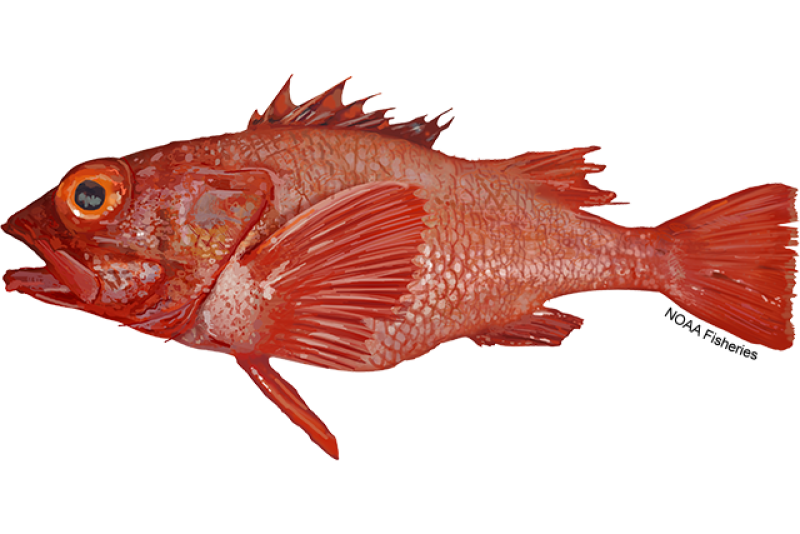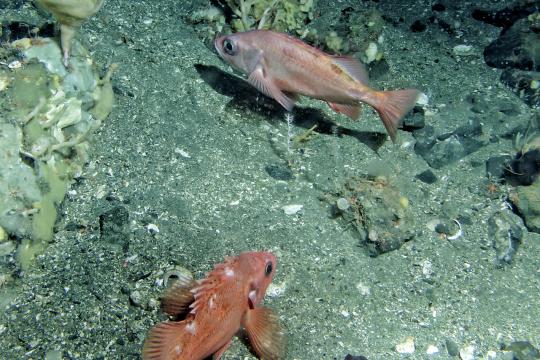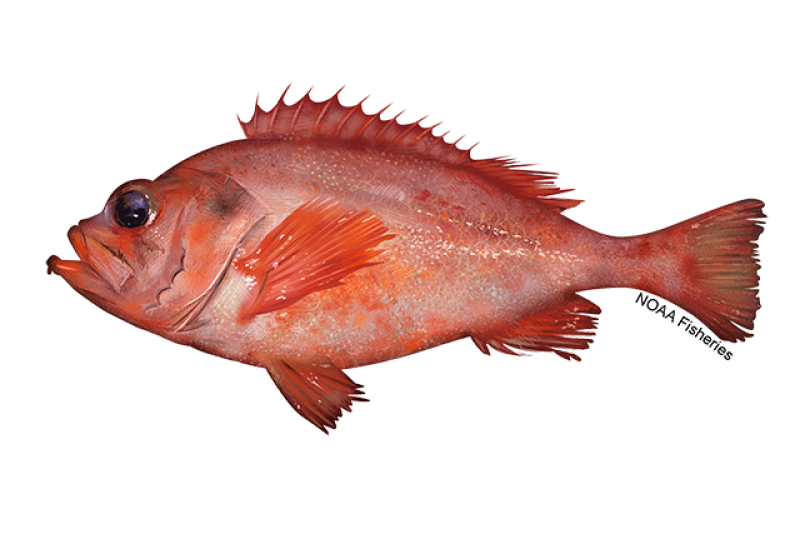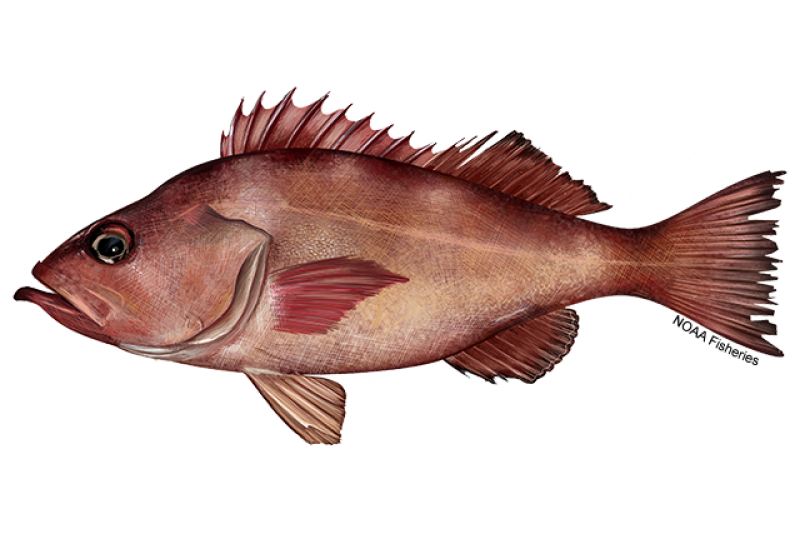 Shortspine thornyhead fish. Credit: NOAA Fisheries/Southwest Fisheries Science Center
Shortspine thornyhead fish. Credit: NOAA Fisheries/Southwest Fisheries Science Center
Shortspine thornyhead fish. Credit: NOAA Fisheries/Southwest Fisheries Science Center
About the Species
 Shortspine thornyhead fish. Credit: NOAA Fisheries/Southwest Fisheries Science Center
Shortspine thornyhead fish. Credit: NOAA Fisheries/Southwest Fisheries Science Center
Shortspine thornyhead fish. Credit: NOAA Fisheries/Southwest Fisheries Science Center
Shortspine thornyhead are found from the Bering Sea to Baja California, Mexico. They are distinguished from other rockfishes by the spiny ridge across their cheek. Shortspine thornyhead can live in depths up to 1,500 meters, though they are more commonly found between 55 and 465 meters.
U.S. wild-caught shortspine thornyhead is a smart seafood choice because it is sustainably managed and responsibly harvested under U.S. regulations.

Population
The Pacific Coast stock is not overfished.

Fishing Rate
Not subject to overfishing.

Habitat Impact
The trawl, longline, and pot gear used to harvest shortspine thornyhead have minimal or temporary effects on habitat. Area closures and gear restrictions protect sensitive rocky, cold-water coral, and sponge habitats from bottom trawl gear.

Bycatch
Regulations are in place to minimize bycatch of overfished and protected species.
Population Status
- There are three stocks of shortspine thornyhead: Pacific coast, one stock contained in the Gulf of Alaska Thornyhead Rockfish Complex, and one stock contained in the Bering Sea/Aleutian Islands Other Rockfish Complex. According to the most recent stock assessments:
- The Pacific Coast stock is not overfished (2023 stock assessment) and not subject to overfishing based on 2022 catch data. Summary stock assessment information can be found on Stock SMART.
- Shortspine thornyhead is managed as part of the Gulf of Alaska Thornyhead Rockfish Complex and has been assessed, but there is not enough information to determine the populations size so the overfished status is unknown (2022 stock assessment of shortspine thornyhead). This complex is not subject to overfishing based on 2023 catch data. Summary stock assessment information can be found on Stock SMART.
- Shortspine thornyhead is managed as part of the Bering Sea/Aleutian Islands Other Rockfish Complex and has been assessed, but there is not enough information to determine the population size so the population status is unknown (2022 stock assessment). This complex is not subject to overfishing based on 2023 catch data. Summary stock assessment information can be found on Stock SMART.
Appearance
- Shortspine thornyhead have elongated bodies and large heads.
- They have a strong spiny ridge and 16 dorsal spines.
- They are bright red or orange red in color, and often have white patches on their sides, backs, cheeks and spiny dorsal fin tips when seen underwater.
- Their fins can have black patches and there may be dark spots or speckles on their sides.
Biology
- Shortspine thornyheads grow slowly and may reach lengths up to 80 centimeters.
- They may live 80 to 100 years.
- Females grow larger than males, and reach maturity around 18 centimeters, or 8 to 10 years of age.
- Shortspine thornyhead spawn pelagic, gelatinous masses.
- They spawn between December and May along the West Coast and between April and May in the Gulf of Alaska.
- Shortspine feed on shrimp, crabs, zooplankton, amphipods, and other benthic invertebrates.
Where They Live
Range
- Shortspine thornyhead are found from the Bering Sea to Baja California, Mexico.
Habitat
- Shortspine thornyhead can live in depths up to 1500 meters, though they are more commonly found between 55 and 465 meters.
Fishery Management
- NOAA Fisheries and the Pacific Fishery Management Council manage the shortspine thornyhead fishery on the West Coast.
- Managed under the Pacific Coast Groundfish Fishery Management Plan:
- Permits and limited entry to the fishery.
- Limit on how much may be harvested in one fishing trip.
- Certain seasons and areas are closed to fishing.
- Gear restrictions help reduce bycatch and impacts on habitat.
- A trawl rationalization catch share program that includes:
- Catch limits based on the population status of each fish stock and divided into shares that are allocated to individual fishermen or groups.
- Provisions that allow fishermen to decide how and when to catch their share.
- NOAA Fisheries and the North Pacific Fishery Management Council manage shortspine thornyhead as part of the Gulf of Alaska Thornyhead Rockfish Complex and the Bering Sea/Aleutian Islands Other Rockfish Complex.
- Managed under the Fishery Management Plans for Groundfish of the Gulf of Alaska and Bering Sea/Aleutian Islands:
- Thornyheads are managed as a “bycatch only” fishery in the GOA because they are nearly always taken in fisheries directed at sablefish and other rockfish.
- Directed fishing on thornyhead exclusively is not permitted.
Harvest
- Commercial fishery:
- In 2023, commercial landings of shortspine thornyhead totaled 900,000 pounds and were valued at $1.4 million, according to the NOAA Fisheries commercial fishing landings database.
- Gear types, habitat impacts, and bycatch:
- The trawl, longline, and pot gear used to harvest shortspine thornyhead have minimal or temporary effects on habitat. Area closures and gear restrictions protect sensitive rocky, cold-water coral and sponge habitats from bottom trawl gear.
- In the Gulf of Alaska, they are mainly caught with trawl and longline gear as bycatch in the rockfish and sablefish fisheries. On the Pacific Coast, they are targeted in the rockfish fishery with bottom trawl, longline, and pot gear.
- Recreational fishery:
- Thornyheads are occasionally caught in recreational fisheries but are not often targeted, due to the complications of deep-sea fishing.
Scientific Classification
- Shortspine thornyhead are found from the Bering Sea to Baja California, Mexico.
- Shortspine thornyhead can live in depths up to 1500 meters, though they are more commonly found between 55 and 465 meters.
Fishery Management
- NOAA Fisheries and the Pacific Fishery Management Council manage the shortspine thornyhead fishery on the West Coast.
- Managed under the Pacific Coast Groundfish Fishery Management Plan:
- Permits and limited entry to the fishery.
- Limit on how much may be harvested in one fishing trip.
- Certain seasons and areas are closed to fishing.
- Gear restrictions help reduce bycatch and impacts on habitat.
- A trawl rationalization catch share program that includes:
- Catch limits based on the population status of each fish stock and divided into shares that are allocated to individual fishermen or groups.
- Provisions that allow fishermen to decide how and when to catch their share.
- NOAA Fisheries and the North Pacific Fishery Management Council manage shortspine thornyhead as part of the Gulf of Alaska Thornyhead Rockfish Complex and the Bering Sea/Aleutian Islands Other Rockfish Complex.
- Managed under the Fishery Management Plans for Groundfish of the Gulf of Alaska and Bering Sea/Aleutian Islands:
- Thornyheads are managed as a “bycatch only” fishery in the GOA because they are nearly always taken in fisheries directed at sablefish and other rockfish.
- Directed fishing on thornyhead exclusively is not permitted.
Harvest
- Commercial fishery:
- In 2023, commercial landings of shortspine thornyhead totaled 900,000 pounds and were valued at $1.4 million, according to the NOAA Fisheries commercial fishing landings database.
- Gear types, habitat impacts, and bycatch:
- The trawl, longline, and pot gear used to harvest shortspine thornyhead have minimal or temporary effects on habitat. Area closures and gear restrictions protect sensitive rocky, cold-water coral and sponge habitats from bottom trawl gear.
- In the Gulf of Alaska, they are mainly caught with trawl and longline gear as bycatch in the rockfish and sablefish fisheries. On the Pacific Coast, they are targeted in the rockfish fishery with bottom trawl, longline, and pot gear.
- Recreational fishery:
- Thornyheads are occasionally caught in recreational fisheries but are not often targeted, due to the complications of deep-sea fishing.
Scientific Classification
| Kingdom | Animalia | Phylum | Chordata | Class | Actinopterygii | Order | Scorpaeniformes | Family | Scorpaenidae | Genus | Sebastolobus | Species | alascanus |
|---|
Last updated by NOAA Fisheries on 03/26/2025
Featured News
 Chef Rob's Pulled Opah Sandwich. Credit: Sam Wells.
Chef Rob's Pulled Opah Sandwich. Credit: Sam Wells.
Seafood Facts

Is Shortspine Thornyhead Sustainable?
U.S. wild-caught shortspine thornyhead is a smart seafood choice because it is sustainably managed and responsibly harvested under U.S. regulations.
Availability
Year-round.
Source
U.S. wild-caught from the Bering Sea to Baja California, Mexico.
Taste
Sweet and mild.
Texture
Firm, coarse flake.
Color
White.
Health Benefits
Rockfish are high in selenium.
Nutrition Facts
Servings: 1; Serving Weight: 100 g (raw); Calories: 90; Protein: 18.36 g; Total Fat: 1.34 g; Total Saturated Fatty Acids: 0.34 g; Cholesterol: 50 mg; Selenium: 63 mcg; Sodium: 74 mgMore Information
Rockfish Recipes
Looking for some ways to add rockfish into your rotation? We have you covered with these recipes for grilled rockfish kebabs, coconut-crusted rockfish tacos, and more!

Last updated by NOAA Fisheries on 03/26/2025
Seafood News
 Celebrate Culinary Arts Month with a sustainable seafood recipe for every month of the year.
Celebrate Culinary Arts Month with a sustainable seafood recipe for every month of the year.
What Your Birth Month Says About Your Next Seafood Recipe
 Fresh-caught taʻape on ice. Credit: Conservation International Hawaiʻi.
Fresh-caught taʻape on ice. Credit: Conservation International Hawaiʻi.
Reducing Waste and Feeding Communities in Hawaiʻi with a Whole Fish Approach
 Chef Tyler Hadfield’s Curried Skate Wings with Tomato-Masala Chutney
Chef Tyler Hadfield’s Curried Skate Wings with Tomato-Masala Chutney
Ring In the New Year With These Crowd-Favorite Seafood Recipes
 NOAA Fisheries, in collaboration with Blue Ocean Mariculture, is conducting a multi-year pilot study to evaluate observational methods and tools for studying Hawaiian monk seal behavior. Courtesy of Blue Ocean Mariculture
NOAA Fisheries, in collaboration with Blue Ocean Mariculture, is conducting a multi-year pilot study to evaluate observational methods and tools for studying Hawaiian monk seal behavior. Courtesy of Blue Ocean Mariculture
AI Meets Aquaculture to Study Hawaiian Monk Seal Interactions With Net Pens
Documents
First Results of the Tagging of Shortspine Thornyhead in Alaska
Shortspine thornyhead (Sebastolobus alascanus) is a commercially valuable deep dwelling rockfish…
Data & Maps
2023 Assessment Of The Thornyhead Stock Complex In The Gulf Of Alaska
The Gulf of Alaska thornyhead complex remain on a biennial stock assessment schedule with a full…
2022 Assessment Of The Thornyhead Stock Complex In The Gulf Of Alaska
The Gulf of Alaska thornyhead complex remain on a biennial stock assessment schedule with a full…
2021 Assessment Of The Thornyhead Stock Complex In The Gulf Of Alaska
In accordance with the approved schedule, no assessment was conducted for this stock this year,…
2020 Assessment Of The Thornyhead Stock Complex In The Gulf Of Alaska
Rockfish have historically been assessed on a biennial stock assessment schedule to coincide with…
Last updated by NOAA Fisheries on 03/26/2025







